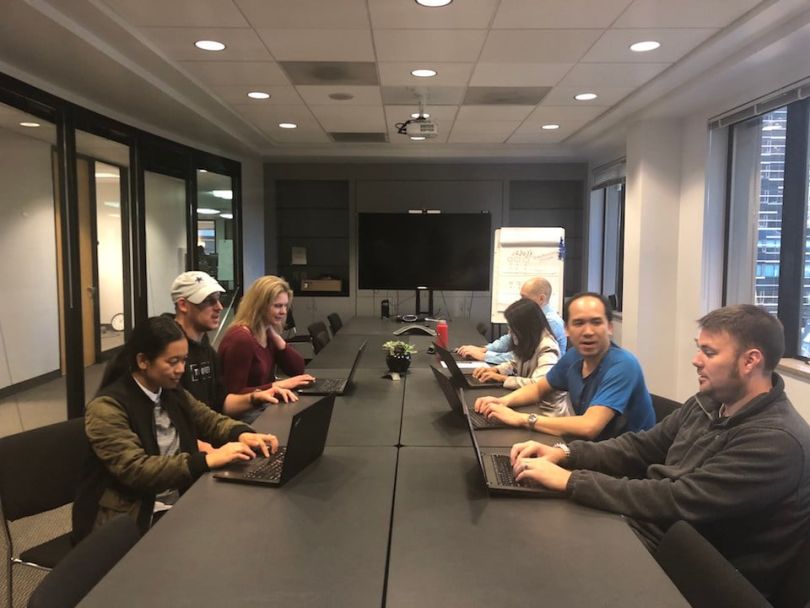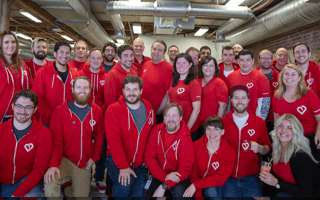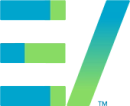Software engineers are eminently practical people — it’s what makes them good at their jobs.
But how do you get people who tend to focus on nuts and bolts to engage with a company’s higher mission? Or with each other? With that in mind, we asked six Seattle engineering leaders at companies large and small to take us through their first year. They shared with us the projects they worked on and the lessons they took from those experiences. Read on for the deets.

Xinova connects its global network of inventors with businesses that have a problem, but lack the tools or bandwidth to solve it. Vice President of Engineering Paul Payne emphasized the importance of collaboration and cohesion within a team, and said he draws inspiration from his workmates and the inventors they’re helping to empower.
What was the biggest challenge you or your team had to overcome in your first year?
In one word: cohesion. Although the core of the team had worked together previously, we were, as a team, responsible for seeding the software development capabilities in a new company with a vastly different context. While we had full autonomy over our own culture and processes, our challenge was to build something entirely new within Xinova. We had to get our minds around the company’s vision, strategy and culture as well as a few million lines of legacy code, a highly customized installation of Salesforce and a decade of loosely-schematized data, all while growing our team from six to 18. We already shipped an excellent new platform this year, but I’m even more proud of how we came together to do it, defining and embodying our culture along the way.
Once you remove the killers of productivity, it’s amazing how much you can get done.”
What were the three biggest lessons you learned in that first year?
First, emphasis on team collaboration, especially quick consensus and process change techniques is essential. We could have easily become mired in figuring out what to do or agreeing on how we should do it; instead, we were able to make productive gains every day while optimizing over time.
Second, working smart is the only solution when you have too much to do with too few resources: concise objectives, prioritization, ruthless scope, focus on MVP, clear abstractions, disciplined design and code review, infrastructure investment, automation, repeatable processes…once you remove the killers of productivity, it’s amazing how much you can get done.
Finally, I think we all found out how many smart people there are with the potential to solve big problems. In the office we’re surround by PhDs, famous scientists and key agents of massive global innovation — but our extended network is truly mind-blowing. It’s humbling to help build a platform for unleashing this talent, capital and technology on the world’s problems. It’s important to stay open to opportunities and new ideas because they’re excellent, and they’re all around us.

Apptentive helps businesses better understand and engage with their customers through a customized feedback platform, and boasts a client list featuring the likes of Zillow, OfferUp, Alaska Airlines, Disney and CNN. Director of Engineering Melody Jones said a company that tries to give a voice to customers must also empower its employees to speak up, and doing so has enhanced her team’s culture as the company scales.
What was the biggest challenge you or your team had to overcome in your first year?
While there have been many challenges, I believe scaling the culture and values that got us here has been unique to my experience at Apptentive. We have a vision that demands a “voice for every customer” — which is quite lofty when you look at our enterprise customer base — and this same vision applies to how we value people and their voice within Apptentive as well. Using their voices, my teammates have asked for a more diverse and inclusive environment, more empowerment in providing “customer love,” as well as more flexibility in when and how they want to work. The entire team’s commitment to our values has allowed us to experiment on new ways to resolve issues like diversity and creative license in a way that has been very open and honest.
The entire team’s commitment to our values has allowed us to experiment on new ways to resolve issues like diversity and creative license in a way that has been very open and honest.”
What were the three biggest lessons you learned in that first year?
1. The useful lifespan of any software we ship continues to shrink and reduces agility. In the early days of software development, companies had systems and programs running for decades. These days, you lose a competitive edge if you’re not spending the majority of your time on your core pillars and “outsourcing” the rest. I know many of us in the big data industry are having to spend more and more time evolving our architectures to optimize for how our cloud providers price their services and balancing that with the ongoing demands of delivering value to our end-customers.
2. Consumer privacy concerns will be the next challenge for the industry. After going through a large GDPR compliance project early this year, as well as reading about all of the breaches and misuses of consumer data in the news, I assume that many other countries will follow suit, and we’ll all have to solve this data ownership and abuse as a community.
3. Recruiting is tough out there! We’ve been working very hard to find ways to add diversity and experience to the team in a very competitive market, but it is tough as a startup when you need that one “unique snowflake” that adds diversity, experience and leadership for an emerging domain.

Hearsay Systems’ Advisor Cloud platform helps businesses attract prospects through social media, communicate with clients through an automated messaging service and provides other tools to build consistent customer experiences that lead exactly to where a business wants to take them. Technical Manager Matthew Peck said it was important to make risk-taking palatable for his team, and thereby encourage innovation.
What was the biggest challenge you or your team had to overcome in your first year?
Like many modern tech startups, we have a product development tradition of hiring smart, motivated developers, telling them what the product should do — and expecting them and their managers to figure out the rest. We’ve worked hard to shift to an Agile, product-driven strategy, wherein an expert product team partners with developers to establish clearly-defined, granular product change stories, priorities and success criteria. The result is happier, more-productive developers — among other benefits.
Embrace failure by lowering stakes. When risk is threatening, conflict is guaranteed.”
What were the three biggest lessons you learned in that first year?
First, don’t hire people for the skills they already have; hire them for their ability to gain skills. The technology you’re using needs to evolve quickly and frequently, and people who readily learn new things will drive that evolution toward ever-better pace of value.
Second, only do work that drives end-user value. No matter how close you are to finishing something, if continued work on it isn’t justified by user value, stop doing it.
Third, embrace failure by lowering stakes. When risk is threatening, conflict is guaranteed. Create a culture of trust, collaboration and consensus by demonstrating that unsuccessful outcomes are just opportunities to learn how to make future success more likely. Good leaders reward their teams for taking risks, especially after failure.

EagleView’s fleet of more than 120 aircraft take aerial images, which the company feeds to machine learning and artificial intelligence algorithms to digitize manual workflows for governments, construction firms, energy infrastructure businesses and insurance carriers. Director of Cloud Operations Josh Leaverton is overseeing EagleView’s cloud migration, and has learned a lot from the experience.
What was the biggest challenge you or your team had to overcome in your first year?
In the first year of its existence, my team was given the seemingly impossible task of migrating all of EagleView’s existing systems and applications into the cloud. This was especially challenging given the complexity of our existing systems, which suffered from a large chunk of tech debt, as well as our critical need to scale our applications to support new imagery products.
The project involved a number of major refactors and the adoption of an entirely new CI/CD pipeline, as well as the implementation of a multi-region cloud infrastructure. With a team comprised of DevOps and Data Engineers, we had our work cut out for us. On top of the technical challenges, we had a varied range of cloud experience on the team, which meant that communication and knowledge transfer have been key. While it has been a long, tough road, we have managed to overcome all obstacles and are on schedule to complete our migration by the end of the year.
Good leadership means being able to balance both daily and long-term tasks across the members of your team.”
What were the three biggest lessons you learned in that first year?
1. Set clear, detailed milestones.
When working on a complex, large-scale effort with a tight deadline, it is immensely important that everyone on the team understands exactly what they should be working on at any given time, why they are working on that task and how it fits into the bigger picture. The Agile process works great at scheduling out short-term goals, but without detailed larger milestones they become almost impossible to prioritize and, at worst, can muddy the waters between technical and business requirements. If the “big picture” and the steps to get there are clearly understood by your team members, it becomes easier for everyone to independently prioritize their own work.
2. Lead by example.
Finding a quick and effective way to handle knowledge transfer on a team with diverse technical backgrounds is extremely hard, especially when the subject matter is as broad as “the cloud.” I had the experts on the team put together clean code examples and templates tailored specifically to our use cases. When combined with self-paced training courses, these helped to quickly spread the skills around the team while keeping productivity up.
3. Delegate.
In the beginning, it may be faster to fix a problem yourself whenever a teammate comes to you with an issue. However, it doesn’t take long to realize that this doesn’t scale — much like our on-premises systems. Good leadership means being able to balance both daily and long-term tasks across the members of your team, and help train those who are less experienced so that they can do more problem-solving in the future.

Amperity’s artificial intelligence algorithms collect and piece together disparate chunks of information to create fully fledged customer profiles, which businesses can use in place of high-level analytics to make decisions and hone their products. Vice President of Engineering Dave Fetterman stressed the need to spread out responsibility for different projects, and learn from clients’ experiences with the tool they are building.
What was the biggest challenge you or your team had to overcome in your first year?
We have a product which processes a staggering amount of data every day, requiring a massive distributed database, a complex machine learning pipeline and a data flow engine to coordinate jobs that require hours of computing. Operating this system requires a great deal of care and domain knowledge. However, we know that in order to scale to the thousands of businesses who, like our first customers, could productively make Amperity the center of their customer data universe, we would have to put more of this intricate system in the customers’ hands, to self-service their own ideas for the data.
[Customers] know so much more than you do about what’s working for them.”
What were the three biggest lessons you learned in that first year?
We learned that doggedly following our core value of “build for durability” from the start really paid off. It’s tempting to find a corner-cutting solution in the interest of time, and many companies celebrate the “hack” mentality: build first, learn, find the real problem you’re trying to solve, throw your original away, and iterate. When our customers scaled their processing by a factor of 100 that year, we amazingly did not need to shed our hard-won original architecture. This was only possible by keeping our focus on the long term from the outset and striving every day for what seemed a near-impossible goal at the cost of any tempting immediate hack.
Putting the product in the customers’ hands was a great lesson too. They know so much more than you do about what’s working for them and where they get the most out of your product. For internally operated tools, you’re willing to tolerate inefficiency and “danger zones.” When you expose the product to the light of day, however, it forces you to raise your own bar much higher.
We also learned that we needed to spread out the responsibility of operating the system. Some engineers, especially the original authors of a service, have such deep knowledge that only they can take care of their baby. By putting new engineers on rotation through the different areas, by establishing a teaching culture, and letting the learners take the wheel, we end up with a much better system: a product resting on the shoulders of the united team, and a company where people can truly grow.

Valant creates cloud-based software for behavioral health practices, clinicians and agencies to streamline their administration and optimize their workflows. Director of Quality Engineering Bosky Atlani lead her team through a jam-packed year, and came out at the end with a succinct set of lessons for anyone setting out to do the same.
What was the biggest challenge you or your team had to overcome in your first year?
We delivered 60 percent of our product roadmap using state of the art cloud infrastructure in a very complex domain of healthcare, built a highly configurable platform and brought a new customer live by displacing their former electronic health record all in about a year. We had to learn the domain, the rules and regulations and figure out how to use technology to create an effective and efficient platform for our customer in a very short time.
We have engineers all across the world, and we needed to...ensure communication was completely transparent.”
What were the three biggest lessons you learned in that first year?
1. Identify and capture metrics early so you can track how you are improving. This is important because what works for small startups may not work once you have grown.
2. Set up processes and tools to make your remote culture successful. We have engineers all across the world, and we needed to make sure we invested in the right tools to ensure communication was completely transparent, so we are all completely integrated even though we are oceans and time zones apart.
3. Grow development infrastructure and leaders in your organization at the pace which you are growing your feature development resources, so you have the right-sized support system for your teams









